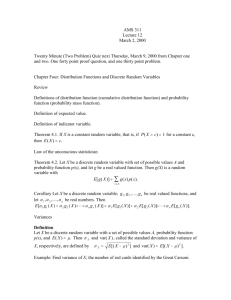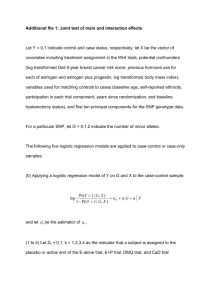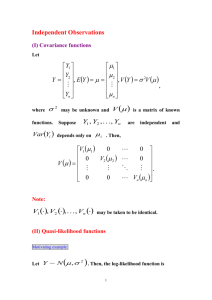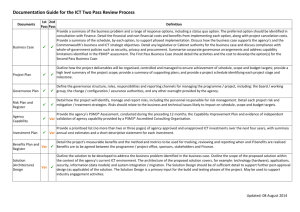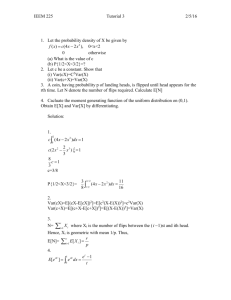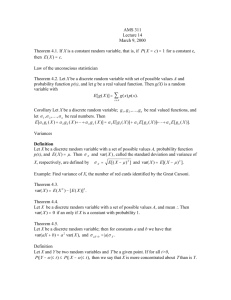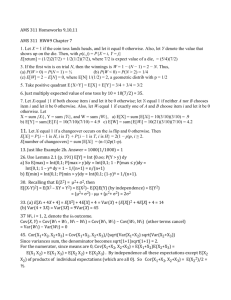Solutions to First Three Homework Assignments
advertisement
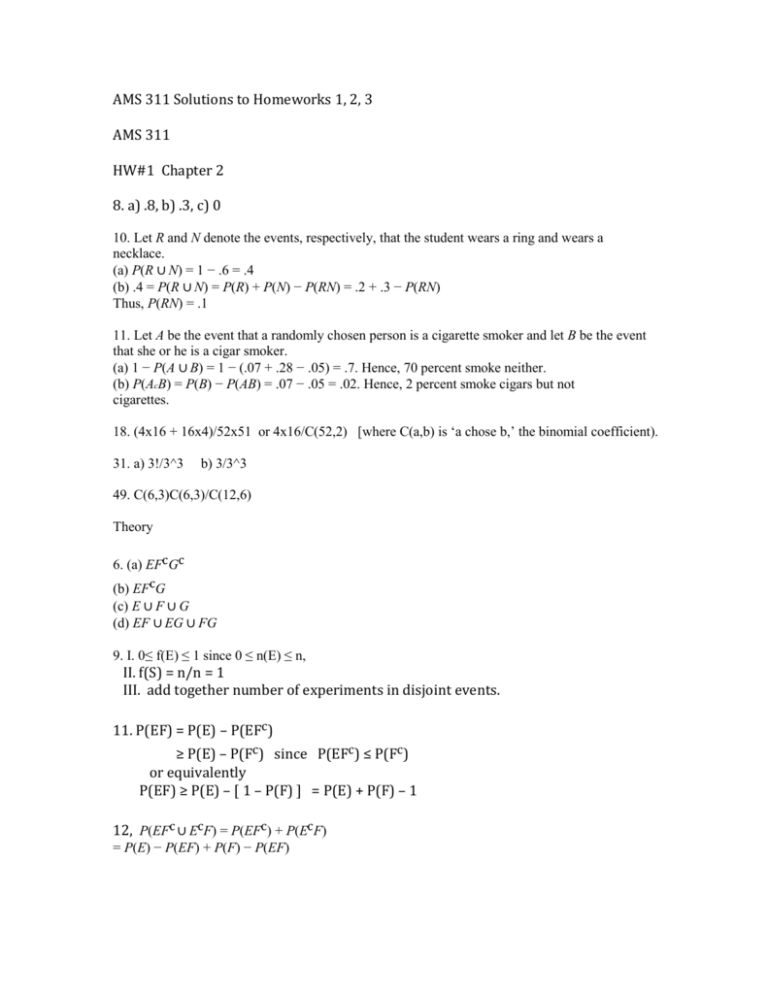
AMS 311 Solutions to Homeworks 1, 2, 3
AMS 311
HW#1 Chapter 2
8. a) .8, b) .3, c) 0
10. Let R and N denote the events, respectively, that the student wears a ring and wears a
necklace.
(a) P(R ∪ N) = 1 − .6 = .4
(b) .4 = P(R ∪ N) = P(R) + P(N) − P(RN) = .2 + .3 − P(RN)
Thus, P(RN) = .1
11. Let A be the event that a randomly chosen person is a cigarette smoker and let B be the event
that she or he is a cigar smoker.
(a) 1 − P(A ∪ B) = 1 − (.07 + .28 − .05) = .7. Hence, 70 percent smoke neither.
(b) P(AcB) = P(B) − P(AB) = .07 − .05 = .02. Hence, 2 percent smoke cigars but not
cigarettes.
18. (4x16 + 16x4)/52x51 or 4x16/C(52,2) [where C(a,b) is ‘a chose b,’ the binomial coefficient).
31. a) 3!/3^3
b) 3/3^3
49. C(6,3)C(6,3)/C(12,6)
Theory
6. (a) EFcGc
(b) EFcG
(c) E ∪ F ∪ G
(d) EF ∪ EG ∪ FG
9. I. 0≤ f(E) ≤ 1 since 0 ≤ n(E) ≤ n,
II. f(S) = n/n = 1
III. add together number of experiments in disjoint events.
11. P(EF) = P(E) – P(EFc)
≥ P(E) – P(Fc) since P(EFc) ≤ P(Fc)
or equivalently
P(EF) ≥ P(E) – [ 1 – P(F) ] = P(E) + P(F) – 1
12, P(EFc ∪ EcF) = P(EFc) + P(EcF)
= P(E) − P(EF) + P(F) − P(EF)
AMS 311 HW2 Solutions
4. P{6 ⏐ sum of 9} = P{(6, 3), (3,6)}/ 4/ 36 = 1/2
P{6 ⏐ sum of 10} = P{(6, 4), (4,6)}/ 3/ 36 = 2/3
P{6 ⏐ sum of 11} = P{6 ⏐ sum of 12} = 1
5. 6x5x9x8/15x14x13x12
8. 1/4/(1/4 + 1/4)
11. (a) P(B⏐As) = P(BAs)/P(A) = {(1x3 + 3x1)/52x51}/{(1x51 + 51x1)/52x51} =
1/17
(b) P(B⏐A) = P(AB)/P(A) = (4x3/52x51)/{(4x3 + 4x51 + 51x4)/52x51}
Note: denominator in (b) could also be 1 – 48x47/52x51
18. a) P(Ind|voted) = .35x.46/A = about .33 , where A = .35x.46 + .62x.3 + .58x.24
= .486
b) P(Lib|voted) = .62x.3/A = about .38 c) P(Con|voted) = .58x.24/A = about .29
d) P(voted) = A = .486
20. a) P(F|C) = .02/.05 = .4, b) P(C|F) = .02/.52 = 1/26
26. Let M be the event that the person is male, and let C be the event that he or she is
color blind.
Also, let p denote the proportion of the population that is male.
P(M|C) = P(C|M)P(M)/( P(C|M)P(M) + P(C|Mc)P(Mc) ) = .05p/(.05p + .0025(1-p)
where p =1/2 or 2/3
Extra Problems
A. (i) False—in this case P(A|B) = 0
(ii) False-- P(AAB) = P(AB) ≠ P(A)P(AB) {= P(A)(P(A)P(B)) }
iii) False-- P(A|B) + P(B)
(iv) True -- P(A|C) ≥ P(A) + P(C) – 1 = .8 (Chapt 2, Theory Exercise #11)
while P(B|C) ≤ P(B) = .5
B. P(hit target) = 1 – P(all miss target) = 1 - .4x.3.x.2 = 1 - .024 = .976
C. Independent: P(A) = 2/6 = 1/3, P(B) = 21/36 = 7/12, P(AB) = 7/36. So P(A)P(B) +
PAB).
AMS 311 HW 3 Solutions
7. a) 1 to 6, d) 0 to 5
8. (a) p(6) = 1 − (5/6)2 = 11/36, p(5) = 2 1/6 4/6 + (1/6)2 = 9/36
p(4) = 2 1/6 3/6 + (1/6)2 = 7/36, p(3) = 2 1/6 2/6 + (1/6)2 = 5/36
p(2) = 2 1/6 1/6 + (1/6)2 = 3/36, p(1) = 1/36
(d) p(5) = 1/36, p(4) = 2/36, p(3) = 3/36, p(2) = 4/36, p(1) = 5/36
p(0) = 6/36, p(−j) = p(j), j > 0
13. p(0) = P{no sale on first and no sale on second}
= (.7)(.4) = .28
p(500) = P{1 sale and it is for standard}
= P{1 sale}/2
=[P{sale, no sale} + P{no sale, sale}]/2
= [(.3)(.4) + (.7)(.6)]/2 = .27
p(1000) = P{2 standard sales} + P{1 sale for deluxe}
= (.3)(.6)(1/4) + P{1 sale}/2
= .045 + .27 = .315
p(1500) = P{2 sales, one deluxe and one standard}
= (.3)(.6)(1/2) = .09
p(2000) = P{2 sales, both deluxe} = (.3)(.6)(1/4) = .045
20. (a) P{x > 0} = P{win first bet} + P{lose, win, win}
= 18/38 + (20/38)(18/38)2 ≈ .5918
(b) No, because if the gambler wins then he or she wins $1.
However, a loss would either be $1 or $3.
21. (a) E[X] since whereas the bus driver selected is equally likely to be from any of the 4 buses,
the student selected is more likely to have come from a bus carrying a large number of
students.
(b) P{X = i} = i/148, i = 40, 33, 25, 50
E[X] = [(40)2 + (33)2 + (25)2 + (50)2]/148 ≈ 39.28 2
E[Y] = (40 + 33 + 25 + 50)/4 = 37
22. Let N denote the number of games played.
(a) E(N) = 2[p2 + (1 − p)2] + 3[2p(1 − p)] = 2 + 2p(1 − p)
The final equality could also have been obtained by using that N = 2 + I where I is 0 if
two games are played and 1 if three are played. Differentiation yields that
d E[N]/dp = 2 – 4p. So minimum occurs when derivative is 0, i.e., p = 1/2
23. (a) Use all your money to buy 500 ounces of the commodity and then sell after one week.
The expected amount of money you will get is
E[money] = (1/2)500 + (1/2)2000 = 1250
(b) Do not immediately buy but use your money to buy after one week. Then
E[ounces of commodity] = (1/2)1000 + (1/2)250 = 625
35. If X is the amount that you win, then
P{X = 1.10} = 4/9 = 1 − P{X = −1}
E[X] = (1.1)4/9 − 5/9 = −.6/9 ≈ =−.067
Var(X) = (1.1)2 (4/9) + 5/9 − (.6/9)2 ≈ 1.089
37. E[X2] = [(40)3 + (33)3 + (25)3 + (50)3]/148 ≈ 1625.4
Var(X) = E[X2] − (E[X])2 ≈ 82.2
E[Y2] = = [(40)2 + (33)2 + (25)2 + (50)2]/4 = 1453.5, Var(Y) = 84.5
38. (a) E[(2 + X)2] = Var(2 + X) + (E[2 + X])2 = Var(X) + 9 = 14
(b) Var(4 + 3X) = 9 Var(X) = 45



